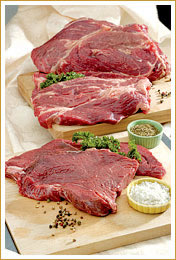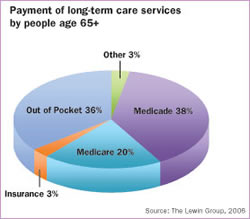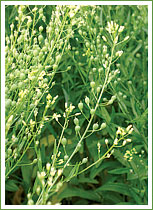|
Science Update
$1.1 million grant funds UI nutrition experts’
efforts to address obesity in young children
by BILL LOFTUS
UNIVERSITY OF IDAHO CHILD NUTRITION AND DEVELOPMENT EXPERTS are
par t of a team using a $1.1 million U.S. Depar tment of Agriculture grant to help
parents and childcare operators better address issues of childhood obesity.
UI College of Agricultural and Life Sciences researchers Laurel Branen, Coeur
d’Alene, and Janice Fletcher, Moscow, are studying the perceptions of parents
and childcare providers.

photoİDREAMSTIME.COM
The need is clear for childcare staff to communicate with parents about
sensitive issues such as children’s weight and need for physical activity, say
the two UI professors of family and consumer sciences. Fletcher quotes data
that show children who were over weight at 3 years old were over weight at 12;
children who weren’t over weight at 3 weren’t at 12.
Branen and Fletcher have inter viewed childcare providers and parents to
better understand issues they face. Cultural aspects of the family guide eating
habits, and those habits, along with children’s physical activity, af fect the risk
of obesity. But weight and eating issues are dif ficult for childcare providers to
address, Branen said.
Challenge of discussing a child's obesity
“It is much easier for childcare providers to talk with parents about a child
development issue than feeding or nutrition or that a child seems to be
developing a weight issue,” said Branen. About obesity in young children,
Fletcher said, “We may not see it in 2- and 3-year-olds, but we’re definitely
seeing it in 4- and 5-year-olds.”
This USDA National Research Initiative grant includes University of Colorado
researchers and colleagues at Washington State University. Next phase of the
project includes development and dissemination of information collected from
parents and childcare operators. The end goal is to provide information and
training modules through a Web site with the help of Erik Anderson, director of
the college’s educational communications unit.
Contact Janice Fletcher at jfletcher@uidaho.edu or Laurel Branen at
ljbranen@uidaho.edu.
Helping dairies increase cull-cow value

photoİDREAMSTIME.COM
In the past, dairy producers sent their “cull” cows to market when milk prices were low or replacement heifers were cheap. If the cows spent no time in the feed yard and their meat was subsequently a little tough, so what?
They were just going to be processed into hamburger or bologna anyway. Not anymore. Today, more than half of the beef from these cattle is fabricated into near- by 20 dif ferent wholesale cuts, including mari- nated steaks, roasts, deli roast beef, fajitas, and other high-value products.
What's new
That’s why Jason Ahola, University of Idaho Extension beef specialist, is helping Idaho’s dair y producers improve meat quality of cull livestock. Results from a trial comparing the carcasses of cows fed a high corn diet for 90 days before har vest to those har vested immediately of f the dair y were so impressive that a large-pen trial involving 180 cows from Idaho dairies begins this summer, funded by
the National Cattlemen’s Beef Association.
Results: At the trial’s star t, 9 cows were harvested and their carcasses compared to those of 18 cows fed the special diet for 90 days. The “fed” cows gained an average of
254 pounds of live weight, resulting in 198
pounds of additional carcass weight.
Both fat color and marbling—traits desired
by consumers—improved in the fed cows. A
12-member taste panel evaluating cooked
steaks from both groups found fed cows had
more desirable tenderness and juiciness.
Contact Jason Ahola at jahola@uidaho.edu
Should Idahoans buy long-term care insurance?
by Mary Ann Reese

Nursing home costs averaged more than $57,000 a year in Idaho during 2007,
and assisted living costs averaged
$40,000 a year. So, is long-term care
insurance right for you? Answers are not
easy. But a comprehensive sur vey and
repor t focusing on Idaho in 2007 can
help you decide.
University of Idaho Extension educator
Lyle Hansen in Jerome County worked
with Cathy McDougall of AARP Idaho and
Genii Hamilton and Nora Wells of the
Idaho Depar tment of Insurance to conduct the first sur vey of Idaho nursing home and assisted living facilities. Findings are
summarized along with do’s and don’ts at the URL below.
Report is free; phone AARP or download it
Title of the 22-page doc
ment is Idahoans Guide to Long-term Care Insurance and Services Prices.
The report lists nursing facilities by city and includes phone numbers and private and
semi-private room costs for each. It also lists companies of fering long-term care insur
ance in Idaho and monthly premiums for people aged 55 to 70 as of spring 2007.Consumers who want a free hard copy of the guide can call AARP Idaho at
208.855.4002.
Seminars on long-term care will be of fered in Boise June 14 and in
Nampa June 28.
For more details contact Beverly Healy, UI Extension, 208.377.2107
or bhealy@uidaho.edu. For information on additional long-term care seminars, call
Hansen at 208.324.7578.
Download the report at http://extension.ag.uidaho.edu/Jerome. Contact Lyle Hansen at lhansen@uidaho.edu for more workshop dates.
Nanowires may help fight diseases
by BILL LOFTUS
Experiments using the toxin that makes E. coli O157:H7 lethal helped show that
silicon nanowires someday could carry drugs into cells to fight disease.
A team of microbiologists and physicists from the University of Idaho and Seoul
National University coated nanowires with fibronectin, the molecule critical for cell
interactions, then attached a fragment of Shiga toxin from the lethal E. coli. The toxin
cannot enter cells alone.
The study showed that nanowires—2,000 of which equal the diameter of a human
hair—could carry the toxin into cultured human cells and kill them.
A nanowire drug delivery system could be used to deliver to cells drugs with low
doses and reduced toxicity, said the researchers. For example, nanowires may be
used to deliver anti-cancer drugs, insulin, or other agents to counteract the effects
of foodborne bacteria, including E. coli 0157:H7.
University of Idaho microbiologists Greg Bohach, Carolyn Hovde Bohach, and
physicist David McIlroy led the research team.
The study was published in the American Chemical Society journal Nano Letters.
The study was funded in par t by an initiative created by University of Idaho President
Tim White. BANTech, the research program, received $1.66 million over five years to support the development of bionanoscience on the Idaho campus.
See www.ag.uidaho.edu/bantech/. Contact Greg Bohach at gbohach@uidaho.edu.
Research arms potato growers with new control for wily wireworms
by MARLENE FRITZ
An insecticide previously approved only for field corn and non-crop uses is available to potato growers this spring, thanks to an integrated pest management project for wireworm control led by University of Idaho entomologist Juan Manuel Alvarez. The insecticide fipronil is in a newer class of chemicals called phenylpyrazoles.
All other insecticides currently used against wireworms are organophosphates and carbamates—older classes of chemicals being scrutinized by the U.S. Environmental Protection Agency.
After four years of side-by-side comparisons at the University of Idaho’s Kimberly Research and Extension Center, Alvarez says fipronil per formed more effectively and consistently against wireworms than any other chemicals evaluated.
Not only did it hold wireworm damage to the lowest percentage of affected tubers and the lowest number of holes per tuber, it did so without reducing the potatoes’ highly valued size.
“We’re excited about it,” says Keith Esplin, executive director of the Potato Growers of Idaho. “Although not perfect, it’s a better control, and we’re hoping it helps growers raise a larger percentage of U.S. No. 1s—which will mean more money in their pockets.”
A difficult pest to control
The crop-threatening larvae of click beetles, wireworms have proved especially difficult to control because their life cycle extends as long as six years and because they spend much of it below the reach of the preventative chemicals that growers routinely apply to soils at planting.
Infestations can damage up to a third of the tubers in a field. Funded largely by a grant from the Western Integrated Pest Management Center, studies by Alvarez and entomologist Tom Kuhar of Virginia Tech are continuing to examine improved wireworm monitoring technologies and to evaluate alternative control tactics.
Alvarez is also working with Rich Novy, a USDA Agricultural Research Ser vice potato breeder at Aberdeen, on building wireworm resistance into new varieties.
Contact Juan Alvarez at jalvarez@uidaho.edu.
Frozen-food cooking directions on store packages may allow foodborne ills
by ERYN TEHAN
Labeling on many packages of frozen beef patties does not provide adequate safe-cooking information for consumers. University of Idaho Extension food safety specialist Sandy McCurdy worked with School of Family and Consumer Sciences senior Katrina Finley to survey cooking instructions on 20 brands of frozen ground beef patty packages from 16 retail stores in four western states.
“Most packages—31 of 38 package types surveyed—correctly stated that meat should be cooked to 160oF, which is the appropriate temperature to kill foodborne diseases,” said McCurdy. “But suggested cooking times to reach that temperature were often inadequate, our tests showed.”
Finley surveyed label instructions, and then used special heat sensors and software to test the time each meat patty took to reach 160oF throughout. Both electric and gas stoves were used at low, medium, and high heats.
Labels suggested cooking times varying from 1.5 minutes to 9 minutes per side for 4-ounce patties. Finley’s tests showed adequate cooking times at 8 to 9 minutes per patty on medium-low heat (250oF) and 5 to 7 minutes on medium-high heat (400oF). Six of 38 packages correctly stated that color was not an indicator of a safely cooked patty, but 5 incorrectly stated the patty should cook until “no longer pink.”
Contact Sandy McCurdy at smccurdy@uidaho.edu.
Tests continue for camelina, potential Idaho oilseed crop
by BILL LOFTUS

photoİSTEPHEN GUY
Moscow’s wintry weather was still a work in progress in early March when niversity of Idaho Extension crop management specialist Stephen Guy began another season of field trials involving the ancient oilseed called camelina.
The tiny oilseed attracting renewed interest in the Nor thwest showed a valuable trait in this year’s University of Idaho field trials: consistency. Guy said the third year of trial plantings produced an average of 2,085 pounds per acre this year—same as for the prior two years.
Those trials were at the UI College of Agricultural and Life Sciences Palouse
Research, Extension and Education Center east of Moscow.
“We learned a lot about many dif ferent things in our camelina field trials this
year,” Guy said. Among the findings: little to no fer tilizer may be required, and
planting time and method are critical.
This year’s trials will explore the ef fects of early planting, either by broadcasting
seeds onto the soil sur face or using a seed drill set shallow.
Contact Stephen Guy at sguy@uidaho.edu.
4-H program helps Idaho
youth see credit pitfalls
by MARY ANN REESE
How many years will it take to pay of f a $2,000 credit card debt if you only repay
the minimum, and how much interest will you pay? These pivotal questions
become jarringly real to Idaho youth who par ticipate in a new 4-H Kids Kredit
Cards program.

photoİDREAMSTINE.COM
Designed by two University of Idaho Extension educators, the exercise begins when par ticipants are issued pretend credit cards with $1,000 or $2,000 limits. They shop in a simulated mall, buying cell phones, music CDs, iPods, ski passes, Xboxes, and brand- name clothes. “They’re very excited,” says Lyle Hansen, who created the program with Donna Gillespie. “Do we really get these things?” they ask. After shopping, the youth, ages 8 to 18, star t doing the math.
Answers are sobering
Youth who spend $2,000 at 18 percent interest, with a 3 percent minimum payment, learn it will take 11 years and an extra $1,654 in interest to pay the debt. “I hope it helps them avoid mistakes I made in college,” says Hansen.
So far 100 youth in Minidoka and Jerome counties have par ticipated. This spring Hansen shared the program at a U.S. Western Extension conference in Boise.
Contact Lyle Hansen at lhansen@uidaho.edu.
|